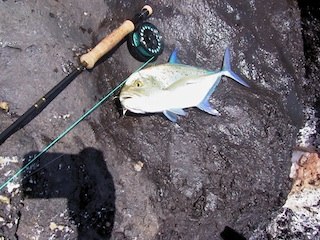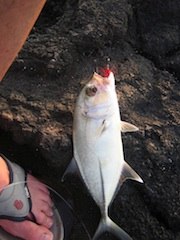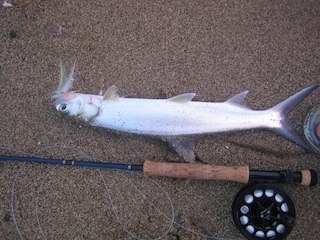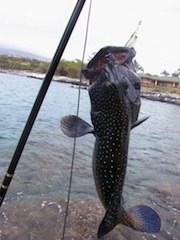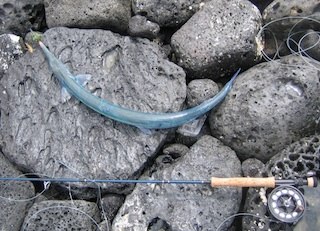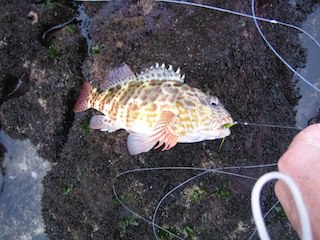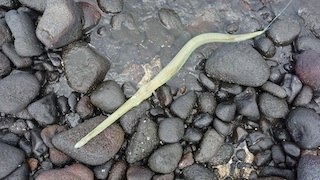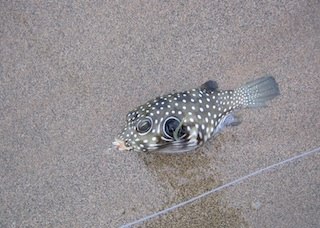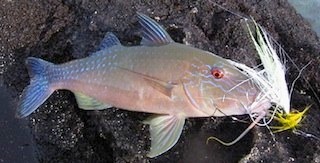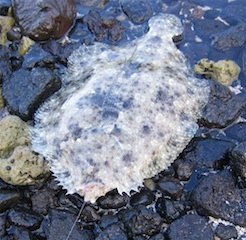Fly Fishing Hawaii: Big Island

I have the good fortune to travel regularly to Hawaii, mostly the Big Island. Some 15 years ago, I started taking a fly rod and checking out various beaches in my spare time. Big Island shore fishing is fun, but not that productive. If you are heading there, take a rod for sure, but I don't think this will ever be a destination saltwater fly fishing location. The Hawaii waters are beautiful and there are many wonderful areas to be found with some exploring. Shore fishing is very popular among locals. At some of the beaches I go to, I do not always feel completely welcome. But being polite, respectful and talking fishing can usually keep things friendly.
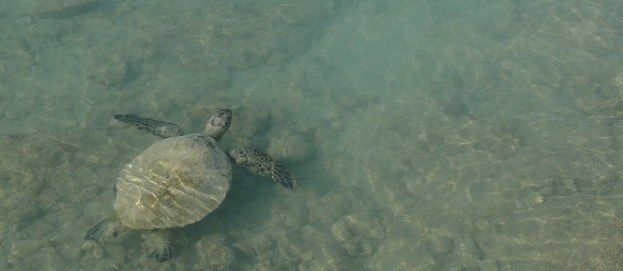
There are more web references to flyfishing in Hawaii every year. Here are a few:
Matt Sakai has an excellent general introduction to Hawaii shore fly fishing here: http://www.ncffb.org/Hawaii_Flyfishing_Primer.htm
A nice description of Hawaii shore fishing by Louis Bignami is here: http://www.finefishing.com/1saltfish/hawaii/easyaffordablehawaii.htm
Use your favorite search engine with the phrase “Oahu bonefish” to get a number of good articles on the excellent fishing for big bones on the flats around Oahu.
Here is a good site with local fish names: http://www.coralreefnetwork.com/marlife/fishes/hname.htm
It is fun to peruse the Hawaii state records: http://www.hawaiifishingnews.com/records.cfm
Finally, I toss all the fish I catch back, but if you are looking for a meal, be aware that Ciguatera toxin is present in some Hawaii near-shore fish. This sounds like a seriously bad experience: Ciguatera link The poison is a micro-organism that grows in marine algaes associated with reefs and gets accumulated up the food chain. The larger barracuda, jacks and trevally are good candidate fish to avoid eating.

THE FISH
Trevally
Omilu from south of Hapuna Beach (click for larger image)
Ulua
I have twice hooked what feels like a freight train that I have zero chance of slowing down or turning. I'm guessing these are Great Trevally -- `white ulua' although it has been suggested to me that they might be manta rays (and they could simply be 10lb bluefin trevally). One day while fishing the bay near Spencer's State Park a bait guy next to me caught two ulua on some heavy tackle. One was maybe 15lbs, the other 20lbs and I would have had a very difficult time dealing with either with the 8wt. These fish seem most common where there is access to deeper water. A good time to catch them is when the surf is up and the water is murky right offshore. Fishing for big ulua is almost a way of life for some hawaiians. There is specialized tackle and techniques, legendary figures in the game and a WWW site devoted to the pursuit where you can get a flavor for the culture. Ulua talking
Barracuda (Kaku)
There are two species of barracuda in the near-shore waters. The Great Barracuda (Kaku) and the slimmer, smaller Heller's Barracuda (Kawele'a). I've seen some big boys (40") right there in Kona off the seawall but most commonly I catch juvenile kaku. Three good spots are the fish ponds just south of the airport, at A-bay and in front of the Waikoloa Hilton. They lurk right next to shore. If you drag a fly behind as you walk along the beach you'll often be surprised with a strike and hookup. The biggest I've caught are only 24" or so. You definitely want to have a wire leader or at least a heavy bite tippet. I've discovered `Tyger Wire' -- a knotable multistrand wire with a nylon coating. It is thin enough in the 15lb version that you can use it pretty much all the time and be ready for the odd kaku.
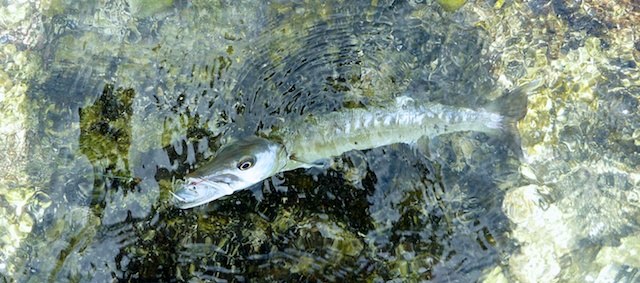
Barracuda from the bay in front of the Waikoloa Hilton
Bonefish (O’io)
After many hours fishing the Kona Coast beaches, in Jan 2004 I had my first excellent shot at a school of bonefish. It was at A-Bay, just north of where the ancient pond empties into the bay. The tide was going out, I was stripping in a black bunny leech. 30 feet out I realized there was a group of about ten big (8 - 10 lb) bones right behind it. A little twitch and two of them rushed over. The first one grabbed my fly -- I jerked it right out of the fish's mouth! Second one then grabbed it and I did the same thing. It is enough said that I had a few more shots and blew every one.
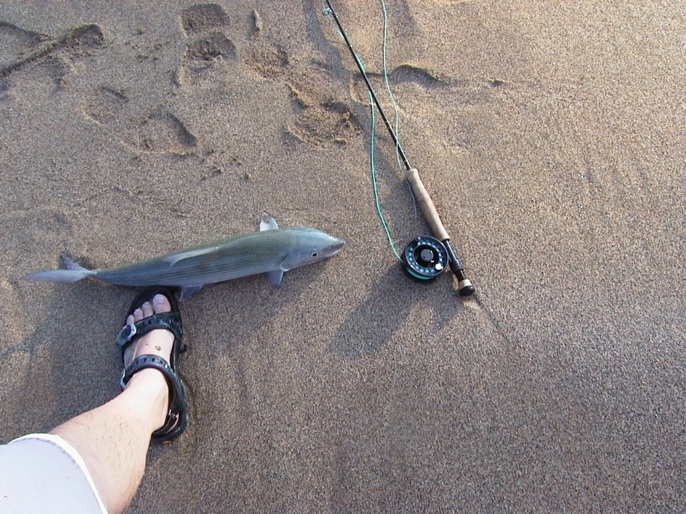
The next month I caught my first bonefish there at the north end of A-Bay. Big fish at around 8lbs and it made two blistering runs. Since then I have caught several more, but it is not easy! The water is just deep enough most places that sight fishing is not the game. Instead, I concentrate in the sandy beaches and incoming tides. Cast out with a small (#6) shrimpy thing, usually in brownish with rubber legs. Strip it in sooooo slowly. Strip set on any resistance. Most of the time, you are hung up on a rock or coral, but every once and a while the line starts zipping out faster than you can believe.
Misc Fish
There are lots of interesting fish that seem to be willing to take a fly in Hawaii. The first below is a ladyfish-like “awa-awa” (not to be confused with the Milkfish known locally as “awa”) and the bottom image is of a Peacock Grouper or Spotted Roi. These lurk in the rocks, flash out to grab your fly, then flash back in to the rocks and wedge themselves into a crevice. Sometimes you imagine you have simply hung up on a rock. But, keep the pressure on and they will make a dash to another crevice.
Awa-awa (ladyfish: click for larger image)
Spotted Roi (click for larger image)
Aha (giant needlefish: click for larger image)
Hawkfish (click for larger image)
Trumpetfish (these can be a nuisance)
Boxfish (click for larger image)
some kind of goatfish (click for larger image)
Peacock flounder (click for larger image)
THE PLACES
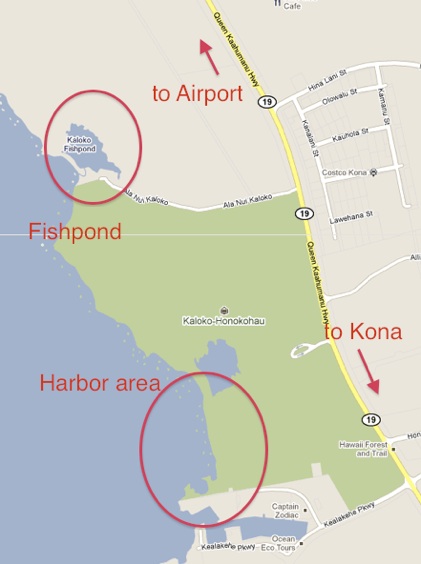
Fish Pond: Just north of H-harbor is a dirt road with a gate (open till 3:30pm). West on this road takes you to one of the large, ancient fish ponds. This was once one of my favorite spots, but starting in 2010, the access was limited to protect the flats where the ocean flows into pond. There are large and small barracuda in this pond, bonefish and trevally.
Kona Natural Energy Lab: This is just south of the airport. There is a parking area, restrooms and a shower (place to clean a rod and reel) and a mile or more of coastline with a cliff ranging from a couple feet to 10 feet above the water level. There are many possibilities here, but this is big water. Often this area gets slammed by big waves. You have to be careful. I've caught papio and peacock grouper in the little bays and slots and have a feeling this would be someplace to concentrate on if you are looking for bigger fish.
Kona Coast State Park (Kekaha Kai Beach): Just north of the Kona Airport off highway 19 turn west onto this well-marked, really rough road (but OK with a 2-wheel-drive car - note that most of the rental-car companies have signs that say you are not supposed to drive off the paved roads) that takes you down to a big parking lot. Straight ahead is a rough coast (with some good potential) and to the north is a beautiful bay with a steep sandy beach. My favorite fishing is to start on the rocks at the mouth of the bay and fish toward the beach. I've caught grouper in the rocks, goat fish and larger trevally here.
Four Seasons Resort/Hualalai: This is about 7 miles north of the airport. There is a gate where you have to ask for a beach parking pass. Follow the signs down to a lot (with restroom and shower). It is a short stroll to the beach. On the right is a path that follows a nice rock area with some deeper water (good omliu water), on the left is a beautiful sand beach with an interesting reef off shore. This is a nice place to wade and cast to coral heads and rocks. At the southern end of the beach is a nice area with big lava rocks and access to good water. This place tends to be deserted.
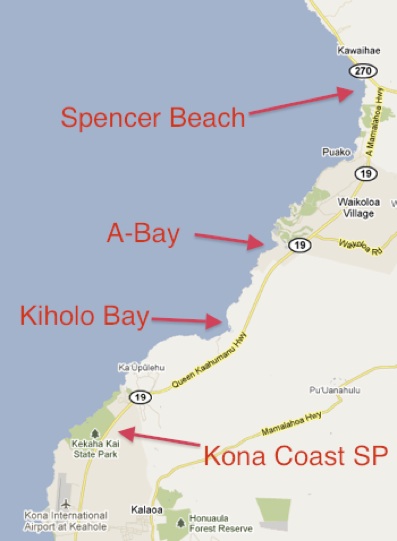
Kiholo Bay: This is a beautiful small bay that is accessible by a mile walk from Highway 19. There is a turnout near milemarker 82 and pretty obvious trail. You can see the bay and identify it by its odd turquoise color from the scenic turnout north of the the Four Seasons Resort. This is a cool spot. There are many turtles and big (20lb) milkfish that are very difficult to get interested in a fly. This bay has bones, barracuda and small and large trevally (image of Kiholo below).
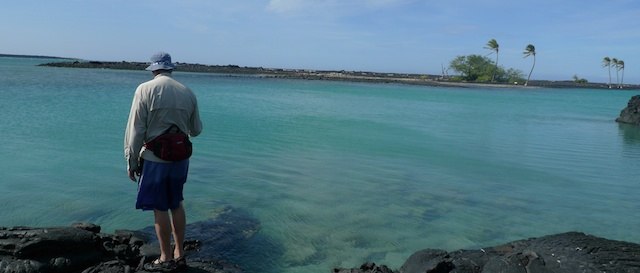
`A-bay' (Anaeho'omalu Bay): is in front of the Outrigger Waikoloa Hotel. Turn off Highway 19 onto Waikoloa Village Road, left at King's Shops to the big parking lot. There is a big, curved sandy beach in front of the hotel and as you go south, you get into reefs and small rocky ledges. This southern area is a good spot for papio and omilu. The north end of A-bay is a pretty good imitation of a classic flat with pockets of sandy areas interspersed with coral and lava. The beach in front of the Waikoloa Outrigger (and big ancient fish pond) is where I have seen (and caught) bonefish and there are often small barracuda crusing in the very shallow water here. In the rock area south of the hotel I've seen ulua right offshore and all along the bay I've had shots at big omilu crusing by fast in pairs. Get there early before the swimmers and snorkelers. This beach was changed quite a bit in 2011 when the tsunami from the devastating earthquake in Japan washed out the center part of the wall defining the ancient fishpond. It is now open to the sea and there is a large sand flat at the outflow.
Walk north for about 1/2 mile along the shore and your get to the Waikoloa Hilton. There is a big natural bay here that can be really good on tide changes. (A-Bay image below)
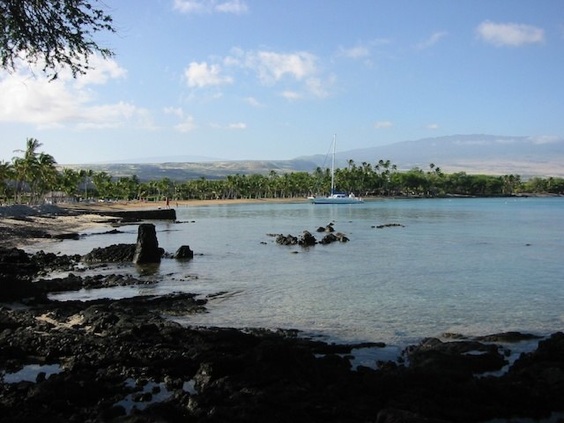
Puako Reefs: Just before getting to Hapuna (when heading north) is a turnoff to Puako. A 3 or 4 mile road runs through a small community with four shore access turnouts. At the first turnout you can walk out onto rocks past big tidepools and access some water over a reef flats. At low tide there is not much water here, but on an incoming tide it looks great. I've never had much luck here, but some of my fishing friends from Hawaii assure me it can be productive (it looks good).
Hapuna Beach: Hapuna is a classic tropical beach. Great place for kids and adults to swim, play in the surf and snorkel. Lots of white sand. The fishing here is at the north and south ends of the beach where you can go out along the cliffs and find spots to drop down close to the water. At the first point on the south end I've caught some nice papio to 3 lbs.
Mauna Kea Beach: To get to this beach you drive into the Mauna Kea Resort entrance and ask for a beach pass. The rocks/cliffs at the south end are good -- be careful for snorkelers. Just around the south corner is a bay with some very deep water (in front of a nice home). At the south end of this little bay is a little lava island. Wade out to it and you are looking at some deep water. I put on a sinking head and find this to be a quite productive area.
Spencer's Beach State Park: Spencer's is a small park with a nice little sandy beach. There are some rocks on the south end that are OK fishing, but the more interesting place is the little bay at the north end of the park. Often in the morning you can see small blacktip reef sharks cruising here. I've tossed flies out in front of these guys ALOT and only one time hooked up (whether it was a take of a foul-hook I'm not sure). I guided the shark toward shore and it was as if it all of a sudden realized something was up and took off. As I got well into my backing, I put on some pressure and broke it off before testing my arbor knot. There are many mullet in the bay and I have seen some big ulua taken by bait guys here. There is a small outcrop of lava with a tree midway up the bay where you will often see fishermen.
Kawaihae area: The big jetties that have been used to create a harbor provide some interesting opportunities. To get there you now have to go through a little security and show some ID. Out in the jetty area there is a shower and stair down into the water and always a few people hanging out. It is a great place to watch the Sun set, at low tide there is a pretty good break about 100 yards off the jetty where people surf and this is a popular spot for spearfisherpeople. The water is 10 - 20 feet deep, has good motion and lots of interesting creatures cruise through. I've seen big (10lb+) trevally cruising through here next to shore, lots of turtles, manta rays and sharks. The casting is a little challenging because if you drop down to the rocks by the water, the parking level is 8 or 10 feet above you and backcasts are tricky. I use a sinking head here.
In the sheltered water between the jetty and the shore there are some old concrete structures. I have often seen small papio working schools of baitfish in here (although I have yet to catch anything in this water) and for some reason I see lots of the giant needlefish in this quiet water.
If you drive through Kawaihae to the parking area at the boat launch there is a little breakwater that gives access to some really deep water. I've caught papio on the inside of the breakwater, nothing on the outside, but it still looks good.
GEAR
I use a fast 8wt (Sage Xi2) and a full-length intermediate line. I have the "Bermuda Triangle Taper" line from Wulff lines. I cut about a foot off the front taper to make it a little more WF and love the line. I end up rollcasting alot and it works great for that. It only comes in clear in the intermediate. At first I didn't care for that, but I've grown to like it just fine. My typical `leader' is 3 feet of 20lb Maxima and 3 feet of 12lb Maxima. The wind blows alot and pretty hard in Hawaii. If it is too wild where I am fishing, I go someplace else looking for protection via cliffs or trees. The rocks can be extremely slippery. I tried lots of different water shoes and sandals that supposedly have sticky rubber, but have switched over to these ugly little sock booties with felt bottoms (called tabis) for $20 in lots of stores in Hawaii. They work very well.
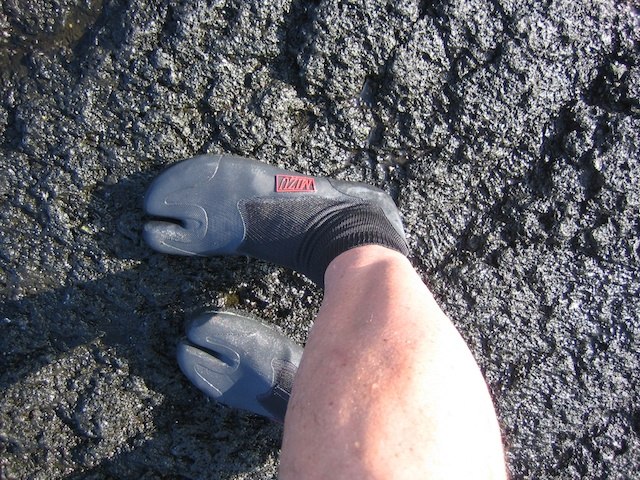
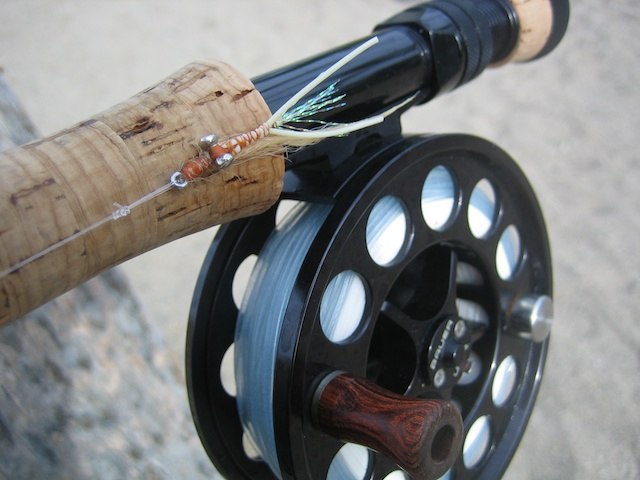
I mostly use relatively small deceiver-like flies with lots of tinsel flash and light-colored clousers (hook size 2) and shrimp-like flies. Ease of casting in the wind is one consideration.
Good luck! Even if you don’t catch much, this makes for a great excuse to discover some of the more remote beaches and enjoy the incredible waters of Hawaii.
Acknowlegments: My guru for local tricks, names and access spots is Jon Chock.
Michael Bolte- bolte@ucolick.org
